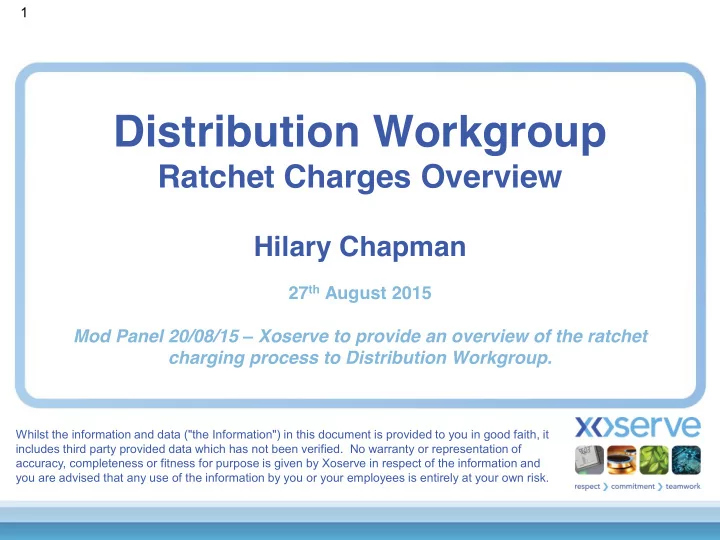

1 Distribution Workgroup Ratchet Charges Overview Hilary Chapman 27 th August 2015 Mod Panel 20/08/15 – Xoserve to provide an overview of the ratchet charging process to Distribution Workgroup. Whilst the information and data ("the Information") in this document is provided to you in good faith, it includes third party provided data which has not been verified. No warranty or representation of accuracy, completeness or fitness for purpose is given by Xoserve in respect of the information and you are advised that any use of the information by you or your employees is entirely at your own risk.
2 What is a Ratchet? • The purpose of a ratchet charge is to act as an incentive for Shippers to accurately estimate and reserve capacity for Daily Metered Supply Points. • If insufficient capacity is reserved, this can have potential safety-related consequences within the Network. • When a ratchet occurs, this has the effect of increasing the DMSOQ and also triggering a charge. • Should repeated ratchets occur, this process will repeat until the PMSOQ is reached, at which point the DMSOQ will be capped. Charges will continue. If the prevailing DMSOQ is equal to the PMSOQ on the day of the ratchet, only the largest ratchet charge within the month shall be charged. • Currently; ratchet charges are billed to the customer via the commodity invoice. However post nexus, it will come under the capacity invoice. • UNC Section B4.7.6: The Supply Point Ratchet Charge shall be calculated as the Capacity Ratchet Amount multiplied by the sum of: (a) 2 times the Applicable Annual Rate (including where determined in accordance with paragraph 1.8.5(a)) of the LDZ Capacity Charge; and (b) where applicable, 2 times the Applicable Annual Rate of the Capacity Variable Component (if any) of the Customer Charge. Abbreviation Definition DMSOQ Registered DM Supply Point Capacity PMSOQ Provisional Maximum Supply Point Capacity UDQO User’s Daily Quantity Off -taken BSSOQ Bottom Stop Supply Point Capacity
3 Ratchet Process Example 1. In this diagram the UDQO is shown by the grey line. The initial DM SOQ is `SOQ1’. 2. When the UDQO exceeds the DMSOQ the ratchet automatically increases the DMSOQ (SOQ2). 3. This will continue each time the UDQO breaches the DMSOQ, until the DMSOQ reaches the Provisional Maximum SOQ (PMSOQ), at which the DMSOQ is capped. 4. If the PMSOQ is breached by the UDQO a series of repeat ratchets will occur. Only the largest ratchet is invoiced once PMSOQ is breached. Abbreviation Definition DMSOQ Registered DM Supply Point Capacity PMSOQ Provisional Maximum Supply Point Capacity UDQO User’s Daily Quantity Off -taken BSSOQ Bottom Stop Supply Point Capacity
4 Potential Solution Options The HLC provided for August UNC Modification Panel 1 details two potential solution options: Option 1 – Suppression of Ratchet charges. - Ratchet will occur (charging and SOQ increase), however the charges will be suppressed prior to invoicing. Option 2 – Adjustment of Ratchet charges. - Ratchet will occur (charging and SOQ increase), and charges and will appear on the relevant invoice. - Shipper would submit a Request for Adjustment to Xoserve, and the charge would be retrospectively credited. Potential further options? The above are subject to assumptions and clarification of requirements…. 1 http://www.gasgovernance.co.uk/panel/200815
5 Assumptions and Requirements Clarifications Assumptions and requirements to be confirmed: - The increase in DMSOQ should be retained? - Eligible population will need to be identified: - All DM components within an aggregated Supply Point? - As at what point in time? - Any exclusions? - Validation by Xoserve: - Light touch? Shipper warranty? - Eg: Check against eligible population only? - More detailed? What does this look like? Reasons for rejection? - E.g: simulate original Supply Point configuration against UDQO values?
6 Any Questions?
Recommend
More recommend